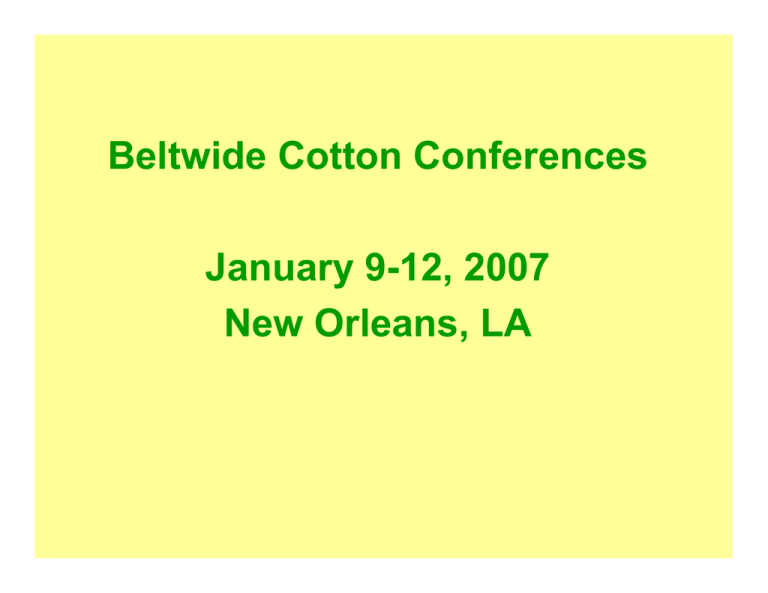Beltwide Cotton Conferences January 9-12, 2007 New Orleans, LA
advertisement

Beltwide Cotton Conferences January 9-12, 2007 New Orleans, LA Simulation Analysis and Economic Impact of Georgia Cotton Production Archie Flanders Center for Agribusiness and Economic Development University of Georgia Production Background • Cotton is largest field crop in Georgia in terms of acreage and revenue. • 1.4 million acres were planted in 2006. • Cotton is an important rotation crop with other crops, especially peanuts. Financial Background • Cotton has high variable costs per acre. • Expensive harvesting equipment leads to high fixed costs. • FAPRI data indicate that US cotton production derives 20% to 30% of revenue from government payments. Georgia Rural Economies • Many rural economies are dependent on agriculture. • Georgia derives 8.6% of economy from agricultural production and directly related manufacturing. • Many GA rural counties derive over 50% of economy from agricultural production and directly related manufacturing. Economic Development • High costs to cotton industry represent economic activity to other industrial sectors. • DP, CCP, and LDP are utilized for input purchases. • Government payments flow into industrial sectors outside of agriculture. Empirical Analysis Methodology • Industry simulation model (Net Returns) • Input-output model (Economic Impact) Industry Simulation • Average production unit is 700 acres. • Model costs derived from UGA crop enterprise budgets and NASS. • Georgia yields and prices are from NASS aggregate data. Simulation Model • NR = Revenue - VC – FC • Revenue = (Price * Yield * 700 acres) + DP +CCP + LDP • DP & CCP (GA base yield (FSA), 700 acres) • VC = 2006 Baseline (Harvesting costs change with yield) Costs Data • VC = $429 per acre - (sell seed to gin) = $390 per acre • Fixed costs are $70,687 for 700 acres. • Costs are industry average, weighted for irrigated : nonirrigated acreages and cotton seed technologies. Average GA Yield and Price Data • NASS yield 2001 : 2006 (Dec. estimate) 726 lbs./acre • FAPRI US price for 2007-2011 is above $0.53/lb. • Current simulation applies $0.529/lb. (10 year GA average) • AWP: 2002-2005 averages $0.048 less than GA market price (Average = $0.481). Stochastic Simulation Covariance: Normal Distribution in Simetar Price Yield AWP Price Yield AWP 0.0053 4.8283 0.0043 12,963 1.9705 0.0039 Average of 500 Iterations $26,624 NR to land & unpaid labor $99,014 GP GP is 25.0% of revenue (Market lint & seed sold + GP) Distribution of GP • 27% goes to farmers and landlords. • 73% goes to input suppliers. Examples: Seed, chemicals, fertilizer, equipment manufacturers and dealers, fuel, electricity, and labor. Economic Impact: Input-Output Model • Itemized cotton industry direct costs are entered into 18 US industrial sectors. IMPLAN (software) • Farm expenditures are direct impacts. • Direct impacts lead to indirect impacts (businesses purchasing from businesses and employees spending income). Direct and Indirect Impacts to US Economy Direct Indirect Output ($) Labor Income ($) Employment (3.3) Total 397,423 919,470 1,316,893 10,021 272,079 2 7 282,100 9 Labor Income is Wealth Created $72,390 (GP-NR) of industry average $99,014 GP leads to $282,100 in labor income to employees and proprietors in US economy. (3.9 Multiple) This does not include income to farmers and landlords. Impacts to US Industrial Sectors Sector Agriculture Mining & Construction Utilities Manufacturing Transportation, Warehousing Trade Finance, Insurance, & Real Estate Services Government and non-NAICS Total Output ($) 527,882 30,175 22,925 293,165 32,390 63,559 97,906 212,767 36,124 1,316,893 Taxes Generated in US Economy by GA Cotton Production Federal Taxes ($) 62,989 State/Local Taxes ($) 45,774 Sum of Taxes ($) 108,763 Compare GP to Taxes Generated $99,014 GP to industry average farm $108,763 Taxes generated by farm $9,749 more taxes generated than received For each tax dollar that the GA cotton industry receives in GP, it generates $1.10 in tax revenues for federal, state, and local governments in the U.S. US Federalist System • Each level of government does what is most appropriate for it to undertake. • Federal government is best suited to sponsor programs for US agricultural commodities. • 58% of taxes generated go back to federal government as new tax revenue. • Remaining 42% goes to state and local treasuries to apply for programs best undertaken by these levels of government. GA Cotton Industry without GP • Average NR with GP is $26,624 • Average NR without GP is -$72,390 Probability of NR < 0 and Greater than $30,000 with GP 100% 80% 60% 40% 20% 0% 0.45 0.27 0.28 NR Probability of NR < 0 and Greater than $30,000 without GP 100% 0.06 0.06 80% 60% 40% 0.88 20% 0% NR Mkt Summary • 73% of GP goes to input suppliers, 23% goes to farmers and landlords. • Each dollar received by GA cotton industry as GP leads to $1.10 in tax revenue. Conclusion • GA cotton industry is not financially viable without GP. • Economic impacts throughout US economy would be lost without GP. • Rural economies have few alternatives to agriculture. Comments and Questions



